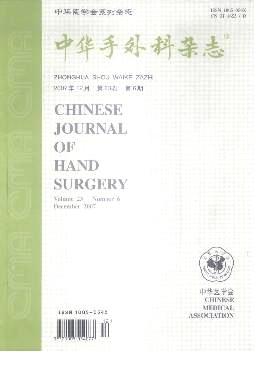Reconstruction of volar plate avulsion injury of proximal interphalangeal joint with mini-anchor
引用次数: 0
Abstract
Objective To investigate the clinical efficacy of mini-bone anchor in the treatment of volar plate avulsion injury of proximal interphalangeal joint. Methods From June 2015 to May 2018, 5 patients with dorsal dislocation of proximal interphalangeal joint caused by finger hyperextension injury were treated. The volar plate avulsion accompanied by articular surface avulsion fracture at the base of middle phalanx occurred. The volar approach was used to remove fragments and reconstruct the insertion of volar plate avulsion with mini-anchor. Results All the wounds achieved primary healing. The follow-up period ranged from 4 to 26 months with an average of 12 months. The flexion and extension of the proximal interphalangeal joint ranged from 50° to 85°. The joint was stable and had no lateral abnormal movement. There was no obvious pain and discomfort during the joint movement. According to the upper extremity functional evaluation criteria issued by the Hand Surgery Society of the Chinese Medical Association, the results were excellent in 2 cases and good in 3 cases. Conclusion The reconstruction of volar plate insertion with mini-bone anchor can provide the initial stability of the proximal interphalangeal joint, help early functional exercise, and help to reconstruct the basal articular surface of the middle phalanx. It is one of the ideal choices for the treatment of volar plate avulsion injury of proximal interphalangeal joint. Key words: Volar plate; Treatment outcome; Proximal interphalangeal joint; Mini-anchor微型锚固件重建指间关节近端掌板撕脱伤
目的探讨微型骨锚钉治疗指间关节近端掌板撕脱伤的临床疗效。方法自2015年6月至2018年5月,对5例因手指超伸损伤引起的近端指间关节背侧脱位患者进行治疗。中指骨基底部掌板撕脱伤合并关节面撕脱骨折。采用掌侧入路取出碎片,并用微型锚钉重建掌侧钢板撕脱伤的插入。结果所有创面均达到初步愈合。随访时间4~26个月,平均12个月。近端指间关节的屈曲和伸展范围为50°至85°。关节稳定,无侧向异常活动。关节运动过程中没有明显的疼痛和不适。根据中华医学会手外科学会发布的上肢功能评价标准,优2例,良3例。结论微型骨锚钉重建掌侧钢板内固定术可提供近端指骨间关节的初始稳定性,有助于早期功能锻炼,并有助于重建中指骨的基底关节面。是治疗指间关节近端掌板撕脱伤的理想选择之一。关键词:Volar板;治疗结果;近端指间关节;迷你锚点
本文章由计算机程序翻译,如有差异,请以英文原文为准。
求助全文
约1分钟内获得全文
求助全文

 求助内容:
求助内容: 应助结果提醒方式:
应助结果提醒方式:


